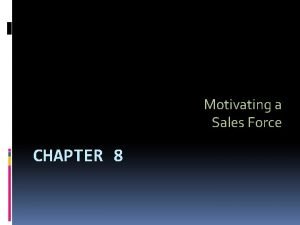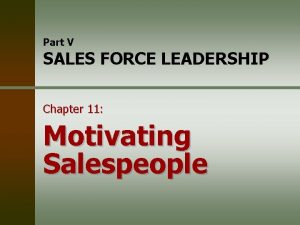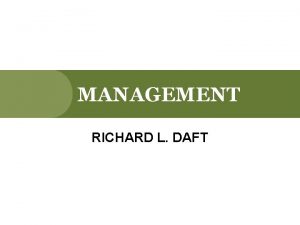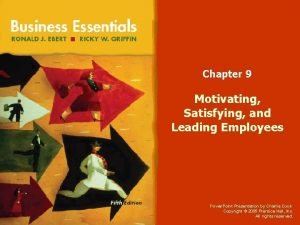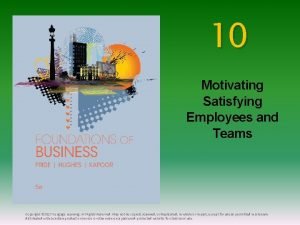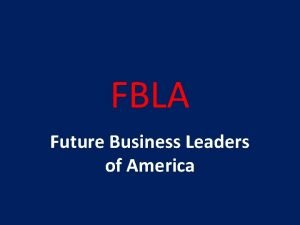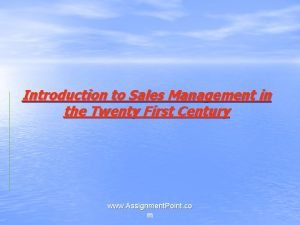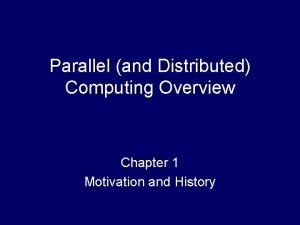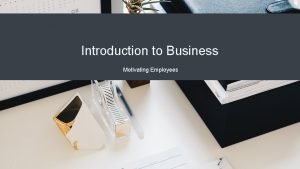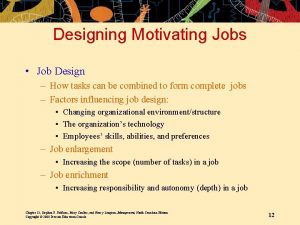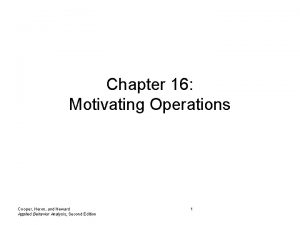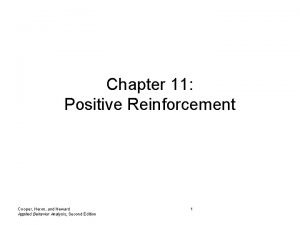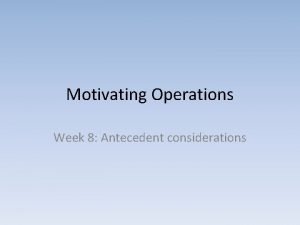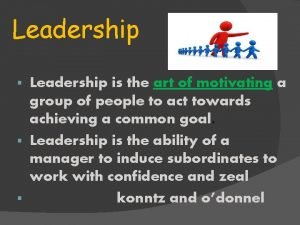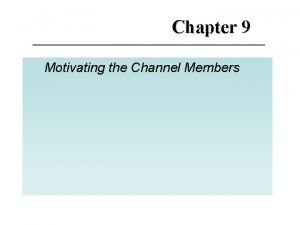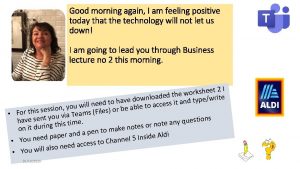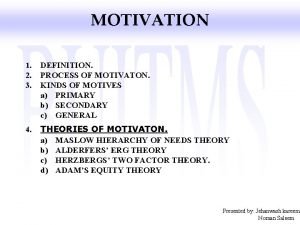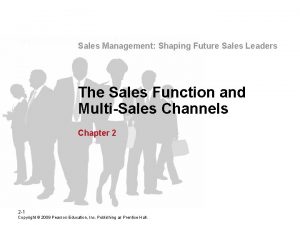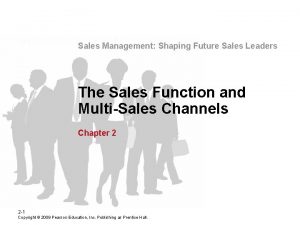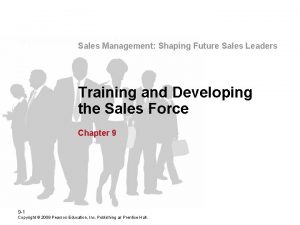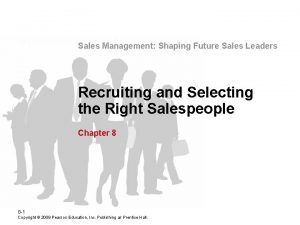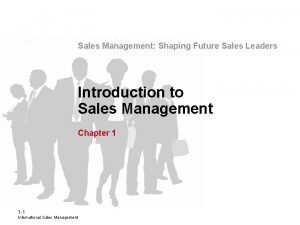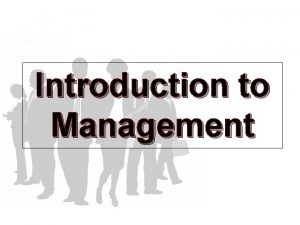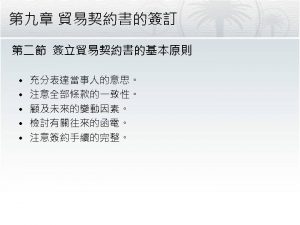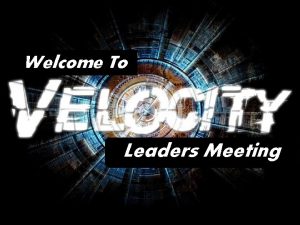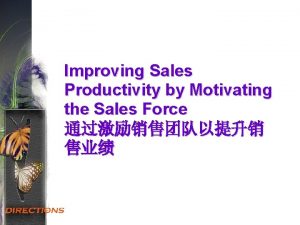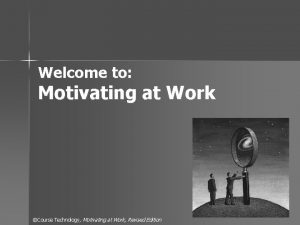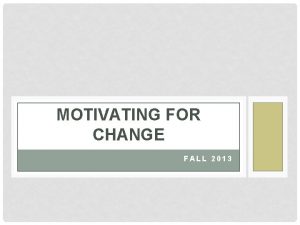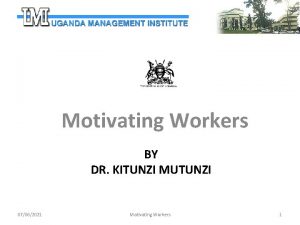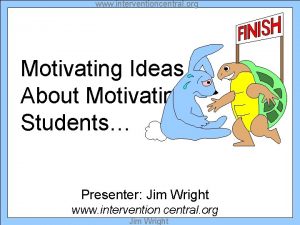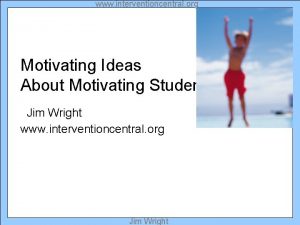Sales Management Shaping Future Sales Leaders Motivating and














































- Slides: 46

Sales Management: Shaping Future Sales Leaders Motivating and Rewarding Salespeople Chapter 12 12 -1 Copyright © 2009 Pearson Education, Inc. Publishing as Prentice Hall.

Learning Objectives § Summarize how motivation has been conceptualized and how the contributions of past studies can be incorporated into managerial activities § Explain the different models of motivation and how sales managers can utilize them § Identify generational differences in motivation and how to adapt motivational approaches for each group § Describe how managers can utilize different motivational elements available to sales organizations § Distinguish different situations in which financial and nonfinancial rewards should be used to motivate salespeople § Illustrate how compensation systems can be utilized to address different motivational needs 12 -2 Copyright © 2009 Pearson Education, Inc. Publishing as Prentice Hall.

What Motivates Salespeople? Intrinsic Motivation Factors Extrinsic Motivation Factors § Things that are done because the person finds doing the activity a reward in itself § Intrinsically motivated people love their work and take pride in feelings of accomplishment it provides them § Less concern or desire for economic or personal gains § External to the job and are done in order to obtain a monetary or physical reward, a social reward, or to avoid punishment § Wages, incentives, awards, job title that reflects status § Extrinsically motivated people focus on what they receive or don’t receive for their efforts § Work is not of utmost importance, it’s what they get for it 12 -3 Copyright © 2009 Pearson Education, Inc. Publishing as Prentice Hall.

Discussion Question § What intrinsic and extrinsic factors motivate you as a student? § What intrinsic and extrinsic factors do you think would motivate you as a salesperson? § What about as a sales manager? 12 -4 Copyright © 2009 Pearson Education, Inc. Publishing as Prentice Hall.

Self-Assessment Library § Go to http: //www. prenhall. com/sal/ § Access code came with your book § Click the following § Assessments I. What About Me? C. Motivation Insights 1. What Motivates Me? 12 -5 Copyright © 2009 Pearson Education, Inc. Publishing as Prentice Hall.

Understanding What Motivates Sales Reps: Content Approaches Maslow’s Hierarchy of Needs § Classifies needs by levels: psychological, security, social, ego, self-actualization § When needs in one level are met, factors in the next level will motivate a person Mc. Clelland’s Needs Approach § People are motivated by various amounts of these needs: achievement, affiliation, power Herzberg’s Motivation. Hygiene § Two-factor approach suggests reps need motivators present and hygiene factors absent or neutral § Motivating factors intrinsic, hygiene factors extrinsic 12 -6 Copyright © 2009 Pearson Education, Inc. Publishing as Prentice Hall.

Understanding What Motivates Sales Reps: Process Approaches Equity Theory § Rep weighs perceived inputs and outcomes in comparison to others and decides if effort/reward ratio is fair, realigns efforts to be rewarding Expectancy Theory § Rep will choose to behave to give them the highest motivational force in order to maximize efforts they find pleasurable and minimize those that aren’t 12 -7 Copyright © 2009 Pearson Education, Inc. Publishing as Prentice Hall.

Content Approaches: Maslow’s Hierarchy of Needs Definition Application § Classifies need § Physiological (basic survival needs) § Security (need to be safe, for shelter) § Social (belongingness, need to have interaction, friendships) § Ego (need to feel good about yourself, receive recognition) § Self-actualization (need to reach fullest potential) § When needs in 1 level are met, factors in the next motivate § Use reinforcements that meet needs at each level § Physiological: salary and bonus § Security: insurance, retirement § Social: work/life balance (flex hours, job share, etc. ) § Ego: recognition for accomplishments § Self-actualization: satisfaction with balance between work accomplishment and home life 12 -8 Copyright © 2009 Pearson Education, Inc. Publishing as Prentice Hall.

Content Approaches: Mc. Clelland’s Needs Approach Definition Application § People are motivated by various amounts of these needs § Achievement (desire to perform challenging tasks) § Affiliation (need to be liked) § Power (need to take charge) § Match reps with rewarding aspects of job § Achievement: provide interesting and stimulating job § Affiliation: provide friendly relationships and avoid confrontational situations or providing negative feedback (effective leaders) § Power: tasks where they can lead, teach or coach 12 -9 Copyright © 2009 Pearson Education, Inc. Publishing as Prentice Hall.

Content Approaches: Herzberg’s Motivation-Hygiene (2 -Factor Approach) Definition Application § Reps need to have a job with motivators present and hygiene factors absent or neutral § Motivating factors are intrinsic to job § Achievement, recognition, the work itself, responsibility, advancement, growth § Hygiene factors are extrinsic § Company policies and admin, supervision, relationship with supervisor, work conditions, salary, relationship with peers, status, security § Consider presence or absence of groups of factors § Make sure rep finds work interesting and challenging § Build motivating factors— opportunities for achievement, recognition, enjoyable work, responsibility, and advancement into activities § Ensure hygiene factors are not considered negative and working as de-motivators 12 -10 Copyright © 2009 Pearson Education, Inc. Publishing as Prentice Hall.

Process Approaches: Adam’s Equity Theory Definition § Rep weighs perceived inputs and outcomes in comparison to others § Decides if effort/reward ratio is equitable, realigns efforts to be rewarding § Inputs: perception of training, experience, effort, hardships, etc § Outputs: perception of compensation, benefits, status, job security, etc § Balancing: compare input/outcome ratio—equity, overpayment inequity, underpayment inequity 12 -11 Copyright © 2009 Pearson Education, Inc. Publishing as Prentice Hall. Application § Consider rep’s perception of motivators in comparison to peers § Be attentive to comments regarding concerns about fairness § Ask reps to explain their perception of how they compare with a top performer

Process Approaches: Expectancy Theory Definition Application § Rep will choose to behave in the manner that gives them the highest motivational force to maximize pleasurable efforts and minimize those that are not § Reps value outcomes differently (recognition, travel, etc. ) § Reps realize different levels of effort are required for tasks § Performances have different likelihoods of producing outcomes; some situations are more certain than others § Focus on highest motivators or on how to raise the level of lower ones § Understand what value reps place on different rewards § Help improve reps performance; make sure they receive good training and are prepared; align reps to clients whose needs are consistent with their abilities § Include other performance measures beyond just a sale and include incentive system that reflects different levels of performance 12 -12 Copyright © 2009 Pearson Education, Inc. Publishing as Prentice Hall.

Generational Motivational Issues Matures Baby Boomers § Raised during Depression and WWII § Know how to follow rules, appreciate more formal communication § Hardworking, loyal, and reliable workers § Want to be respected and want meaningful title reflecting their importance § Admired by Millennial counterparts and have much wisdom that they enjoy sharing with younger workers § Traditional forms of recognition are valued § Allow them to make meaningful contributions § Engage them in mentoring and show respect for their experience § Experienced economic prosperity and periods of social consciousness § Dual-career couples who work long hours and struggle to balance their family lives, which can include kids and elderly parents § Have expectations for others to work as hard as they do § Cooperative teamwork and regular communication is preferred § Value promotions, leadership positions, and public recognition of accomplishments § Flexible working arrangements that help them pursue time with family and individual interests are of increasing value 12 -13 Copyright © 2009 Pearson Education, Inc. Publishing as Prentice Hall.

Generational Motivational Issues Generation X’ers Millennials § Raised by parents who both worked, have shifted workplace emphasis from materialism to focus on family § Moving into managerial positions and prefer independence over teamwork and immediate communication over structured meetings § Computer use and multi-tasking is second nature § Value work opportunities that are changing and allow for opportunity to grow § Flexibility in working arrangements is critical as family time is more important than time at work § Bonus days off may be valued more than the traditional monetary bonus § Soon to be largest group in workforce § Some have experienced tight job markets and moved home § Been counseled to find a good job that’s right for them § Require work-life balance § High level of social consciousness and responsibility and desire an employer who incorporates and displays these values in their work § Being individuals in a team is valued § Like immediate feedback and rewards § Want meaningful work experiences and mentors or coaches who can help them achieve goals and contribute § Flexibility in work environment is a must 12 -14 Copyright © 2009 Pearson Education, Inc. Publishing as Prentice Hall.

Dos and Don’ts of Motivating Reps 1 Hire self-motivated people 2 Show trust 3 Capitalize on unique strengths of employees 4 Encourage some people to become experts 5 Empower reps to make their own decisions 6 Offer rewards that are valued by all 7 Develop or remove deadbeats 12 -15 Copyright © 2009 Pearson Education, Inc. Publishing as Prentice Hall.

Financial and Nonfinancial Rewards What motivates you as a salesperson? § Achieving a team goal and all of us going on a four-day cruise § Receiving a gift from the company president at a company-wide meeting § The owner’s verbal recognition § A work environment that lets me work part of the day at home to balance my family needs § A trip to Hawaii for reaching a sales goal 12 -16 Copyright © 2009 Pearson Education, Inc. Publishing as Prentice Hall.

Financial and Nonfinancial Rewards (continued) § A personal gift selected for me by the company president § Sending me to a seminar that helps me become more productive § A trip to a special spa § Quarterly bonuses. The extra money helps with the bills § Being selected for the President’s club (and the ring or trip that comes with it) 12 -17 Copyright © 2009 Pearson Education, Inc. Publishing as Prentice Hall.

Global Sales Management: “We’re All in It for the Money, Right? ” § (What) one thing would you most like to obtain from your career? § To earn a lot of money #1 § Singapore, UK, US, Chile, Sweden § Use [my] special abilities #1 § Australia, Canada, New Zealand, Norway, Chile, Sweden § Opportunity to do new and exciting things was among top motivators § Opportunity to go into management received mixed ratings Source: Tanner, John F. , Jr. , and George W. Dudley (2003). “International Differences: Examining Two Assumptions about Selling, ” in Advances in Marketing, William J. Kehoe and Linda K. Whitten, eds. , Society for Marketing Advances, pp. 236– 239. 12 -18 Copyright © 2009 Pearson Education, Inc. Publishing as Prentice Hall.

Components of a Reward Program Marketplace Environment How do market and industry factors affect the rewards a firm offers its salespeople? Organizational Culture How does an organization’s culture affect the rewards the firm offers its salespeople? Business Strategies How does the strategy of a business affect the rewards a firm offers its salespeople? Total Rewards Strategy Compensation Benefits Work-Life Rewards Recognition Development 12 -19 Copyright © 2009 Pearson Education, Inc. Publishing as Prentice Hall.

Compensation § Majority of reps compensated under a combination plan, which includes a salary component and a variable pay component § 60% use combination pay plans § 20% use straight salary plans § 10% use commission-only plans 12 -20 Copyright © 2009 Pearson Education, Inc. Publishing as Prentice Hall.

Base Salary § Fixed amount of compensation a rep receives § Cost-of-living allowance (COLA): differential pay based on higher cost of living in an area § Good when firm wants rep to offer exceptional customer service (Saturn), when difficult to trace role of individual in sale, or when rep is just starting out, developing his book of business (clientele) § Advantage: steady income § Disadvantage: productivity not rewarded, reps might produce minimal level of work 12 -21 Copyright © 2009 Pearson Education, Inc. Publishing as Prentice Hall.

Discussion Question § If you were to hold a sales contest and offer a trip as an award, what location would you pick? § For each generation, identify a location that you believe they would find particularly motivating and explain why 12 -22 Copyright © 2009 Pearson Education, Inc. Publishing as Prentice Hall.

Variable (Incentive) Pay § Bonus: lump sum of cash used to reward sales personnel § Stock options: allow reps to purchase their company’s shares at reduced prices § Team-based pay: reward for group productivity § Commission: % of the price of the product or service the rep earns § Progressive plan: increases % of commission rep earns for each progressive level of sales § Encourage rep to sell as much as possible § Regressive plan: decreases % commission rep earns when they sell more products and services § Sets firm limit amount reps can earn when selling an easy-to-sell product or service (order-takers) 12 -23 Copyright © 2009 Pearson Education, Inc. Publishing as Prentice Hall.

Progressive vs. Regressive Plans 12 -24 Copyright © 2009 Pearson Education, Inc. Publishing as Prentice Hall.

Commission-Only Plan § Advantage § Pay only for successful sales efforts—don’t pay reps who do a poor job or don’t contribute to the firm’s profit § Disadvantage § If sales are slow, reps will receive low income, better salespeople will leave § If product takes little effort to sell, reps will earn lots of money without much effort § Risk of reps focusing solely on activities that earn the largest commission 12 -25 Copyright © 2009 Pearson Education, Inc. Publishing as Prentice Hall.

Combination Plan § Includes both salary and incentives § Designed to capitalize on advantages base salary and incentive programs offer and minimize disadvantages § Base salary = security, incentives = motivation 12 -26 Copyright © 2009 Pearson Education, Inc. Publishing as Prentice Hall.

Average Level of Combination Pay (US, 2004 -2006) Commission Base + Bonus 12 -27 Copyright © 2009 Pearson Education, Inc. Publishing as Prentice Hall.

Ethics in Sales Management: What If Compensation System Encourages Unethical Behavior? § Mobile medical device firm, screens for osteoporosis § Marketed services to physicians § Demo device, lay out potential profit for doctors § Great amount of money reimbursed by insurance companies for this exam § Many doctors had all patients scanned to create “baseline” § Company code of ethics would not have had support of top management 12 -28 Copyright © 2009 Pearson Education, Inc. Publishing as Prentice Hall.

How Much is Your Health-Care Benefit Worth? § Question: What is the average amount that employers pay for a family’s health insurance premium? § Answer: $8, 500 (since 2000 employment-based health insurance premiums are up 87%) Source: Henry J. Kaiser Family Foundation 12 -29 Copyright © 2009 Pearson Education, Inc. Publishing as Prentice Hall.

Benefits § ~40% of payroll costs § Legally required = 20% of all benefit payments § § Social Security Workers’ compensation Unemployment insurance Family and medical leave § Optional § Health insurance (~25% of benefit payments) § Retirement or pension (defined benefit programs, ~15% of benefit payments) § Defined contribution (401(k), IRA, etc. ) § Paid time off (vacation, holiday, sick days, ~25% of benefit payments) § Lunch break = ~15% of benefit payments 12 -30 Copyright © 2009 Pearson Education, Inc. Publishing as Prentice Hall.

Work-Life Rewards § Workplace flexibility programs § Leaves of absence § Health and wellness programs § Community involvement programs § Care for dependents § Financial support programs 12 -31 Copyright © 2009 Pearson Education, Inc. Publishing as Prentice Hall.

Fired? For Smoking? § Assume your employer can demonstrate the jobrelated costs of smoking and offers smoking cessation clinics to all employees. Can you be fired for smoking? § Maybe. Scott Rodrigues was fired on his 30 th birthday for being a smoker. The former Scotts Miracle-Gro (the lawn care company) employee is suing the company. Source: “Get Healthy – or Else, ” Michelle Conlin, Business Week, Feb 26, 2008, 4023, 58 -69. 12 -32 Copyright © 2009 Pearson Education, Inc. Publishing as Prentice Hall.

Popularity of Recognition Programs § 85% of companies report their sales managers use recognition rewards Source: Based on Kornik, Joseph (2007). “What’s It All Worth? 2007 Compensation Survey, ” Sales & Marketing Management Vol. 159, No. 4, pp. 27– 39. 12 -33 Copyright © 2009 Pearson Education, Inc. Publishing as Prentice Hall.

Recommendations for Successful Sales Contests § Use them sparingly; if you use contests too frequently or on a predictable schedule, reps might hold back on selling until contest starts § Be selective in what products/services to include; including new, unproven products and services helps motivate reps to learn about them and sell them § Make the rewards you offer attractive to reps of all ages and experience levels; use rewards that motivate all groups 12 -34 Copyright © 2009 Pearson Education, Inc. Publishing as Prentice Hall.

Expense Accounts § Fuel, transportation § Business trips: airfare, lodging, food, car rentals § Home office: laptops and software, cell phones, office supplies and printers, Internet charges, and voice and data communications systems § Unlimited reimbursement plan: all expenses are covered § Per diem plan: rep is allocated certain amount of money for each day traveled § Limited plan: exact amounts for each meal and travel expense are set 12 -35 Copyright © 2009 Pearson Education, Inc. Publishing as Prentice Hall.

Comparison of Expense Account Plans 12 -36 Copyright © 2009 Pearson Education, Inc. Publishing as Prentice Hall.

Personal Development and Career Opportunities § Learning opportunities include access to new educational experiences § Coursework § Corporate athlete § Sales meeting § Mentoring § Succession planning 12 -37 Copyright © 2009 Pearson Education, Inc. Publishing as Prentice Hall.

Role Play: Bio. IDs § Bio. IDs incorporates biometrics into ID cards § Business is growing, largest segment is government § Reps must be available on short notice to work with buying committees § Sales goals are aggressive, competition is growing § District 6 won’t make goal, 2 top reps struggling, satisfaction ratings dropping off § Jerry’s elderly mother moved in 18 mos ago § Rachel has baby with complications 12 -38 Copyright © 2009 Pearson Education, Inc. Publishing as Prentice Hall.

Role Play (continued): Assignment § Divide into pairs § 1 person is sales manager for District 6 § 1 person is regional manager § You both stand to lose $10, 000 in bonuses § District 6 reps will lose $4000 in bonuses if goals aren’t met § National sales manager will request action plan for future § Outline the plan the two of you propose to improve sales § What types of reward programs might you propose? 12 -39 Copyright © 2009 Pearson Education, Inc. Publishing as Prentice Hall.

Caselet 12. 1: Adjusting Compensation Plan to Motivate Reps § Pelican pharma patent expired, drug’s gone generic, can’t retain experienced reps § Does not have blockbuster drug in pipeline § Board of directors rewards reps based on profitability § As sales slumped, sales personnel income declined § New director of sales Frank struggling with motivation and rewards for sales force § Frank wants to change commission structure, kick off upcoming annual sales meeting by outlining new structure § Must make proposal to board of directors to lower quotas § Will highlight total rewards package 12 -40 Copyright © 2009 Pearson Education, Inc. Publishing as Prentice Hall.

Caselet 12. 1 (continued): Adjusting Compensation Plan to Motivate Reps Pelican rewards package § Modest salaries, company cars, and full benefits (some of the best in the industry) § Pays commissions based on salespeople surpassing their previous year’s sales totals § Escalating reward system kicks in once rep hits 80% of quota § Sales contests related to selling the company’s most profitable drugs § Rewards usually consist of trips or merchandise § Average rep is only achieving 75% of quota § Rep earns no commission § Those who do earn bonuses are usually only a few % over quota, so commission checks are marginal § Quotas are set by board of directors and are based on the company’s overall operations overhead and the return shareholders expect 12 -41 Copyright © 2009 Pearson Education, Inc. Publishing as Prentice Hall.

Caselet 12. 1 (continued): Questions 1. What problems do you anticipate Frank will run into when he presents his revised commission structure plan to Pelican’s board of directors? 2. If Pelican were a low-cost, generic pharmaceutical company, how would you as a sales manager reward and motivate sales representatives? 3. What other motivational tools could Frank have used to retain and motivate employees other than adjusting the sales quota downward? 4. Identify other areas within the company that will be affected if Frank’s plan is approved by the board of directors 5. Do you feel the company should have adjusted its commission structure before the patent for its best-selling drug expired? Is it fair to penalize the sales force with lower commissions for an outside competitive factor they cannot control? Explain your answer 12 -42 Copyright © 2009 Pearson Education, Inc. Publishing as Prentice Hall.

Caselet 12. 2: Market-Share vs. Revenue-Based Incentive Systems § Phil sells for Lextron, manufacturer of sterilized medical equipment § In Atlanta, Phil wins sales contests, always makes quota (which increases ~10% annually) § Phil moves to Milwaukee, doubles market share in 2 years, products in 80% of customers in his territory § Running out of new account prospects § Making less in commission than in Atlanta § Manager Mark Green says Phil is doing excellent job, Phil asks why he’s not being compensated 12 -43 Copyright © 2009 Pearson Education, Inc. Publishing as Prentice Hall.

Caselet 12. 2 (continued): Questions 1. How do you think Mark Green should react to Phil’s argument about market share and compensation? (Remember, he just told Phil he was doing an excellent job) 2. Do you believe Phil has been fairly compensated since his move to Milwaukee? What other compensation programs could the company have put in place to avoid this situation? 3. Should Lextron Corporation consider changing its commission structure from one that is revenue-based to one that is market–share based? If so, how might this affect the firm’s other territories. Explain your answer 12 -44 Copyright © 2009 Pearson Education, Inc. Publishing as Prentice Hall.

Caselet 12. 2 (continued): Questions 1. How do you think the size and speed of growth in a metropolitan area like Atlanta affect commissioned salespeople with territories in areas such as this? What about commissioned salespeople with territories with shrinking population bases, such as Milwaukee? 2. Should the territory Phil was working in Atlanta have been split in two—to allow Lextron to capture more market share and keep the market share of different territories around the country and the compensation associated with it on par with one another? 3. Should the existing salesperson in a territory to be split receive any additional compensation of future lost wages because the territory is going to be smaller? Explain your answer 12 -45 Copyright © 2009 Pearson Education, Inc. Publishing as Prentice Hall.

All rights reserved. No part of this publication may be reproduced, stored in a retrieval system, or transmitted, in any form or by any means, electronic, mechanical, photocopying, recording, or otherwise, without the prior written permission of the publisher. Printed in the United States of America.
 Future sales leaders
Future sales leaders Motivating sales force
Motivating sales force Methods of sales force motivation
Methods of sales force motivation Future continuous and future perfect examples
Future continuous and future perfect examples Future perfect simple and continuous
Future perfect simple and continuous মাইক্রোক্রেডিট
মাইক্রোক্রেডিট Motivating and satisfying employees and teams
Motivating and satisfying employees and teams Motivating and satisfying employees and teams
Motivating and satisfying employees and teams Chapter 10 motivating and satisfying employees and teams
Chapter 10 motivating and satisfying employees and teams Motivating and satisfying employees and teams
Motivating and satisfying employees and teams Motivating and satisfying employees and teams
Motivating and satisfying employees and teams Future leaders exchange
Future leaders exchange Ukri future leaders
Ukri future leaders Ukri flf round 7
Ukri flf round 7 Future health leaders
Future health leaders Future business leaders of america definition
Future business leaders of america definition Goals of fbla
Goals of fbla Introduction to sales management
Introduction to sales management Motivating yourself and others
Motivating yourself and others Leading and motivating a team
Leading and motivating a team Human resource management global edition
Human resource management global edition Future perfect future continuous exercises
Future perfect future continuous exercises Tenses summary
Tenses summary Future plans and finished future actions
Future plans and finished future actions Perfect future continuous tense
Perfect future continuous tense Future continuous and future perfect objasnjenje
Future continuous and future perfect objasnjenje Motivating parallelism
Motivating parallelism How to motivate esl students
How to motivate esl students Herzberg’s two-factor theory
Herzberg’s two-factor theory Designing motivating jobs
Designing motivating jobs Motivating operations examples
Motivating operations examples Cooper heron and heward
Cooper heron and heward Motivating operations definition
Motivating operations definition Exploitative authoritative example
Exploitative authoritative example Motivating channel members
Motivating channel members Planning organizing staffing directing and controlling
Planning organizing staffing directing and controlling Motivating software engineers
Motivating software engineers Motivating employees without money
Motivating employees without money Introduction to parallel computing ananth grama
Introduction to parallel computing ananth grama John cabot motivation
John cabot motivation Motivating people for total quality
Motivating people for total quality Reflexive conditioned motivating operation
Reflexive conditioned motivating operation What evidence is there of aldi motivating its workforce
What evidence is there of aldi motivating its workforce Motivating parallelism
Motivating parallelism Motivaton synonym
Motivaton synonym Planning organizing staffing directing controlling
Planning organizing staffing directing controlling Motivating example
Motivating example

